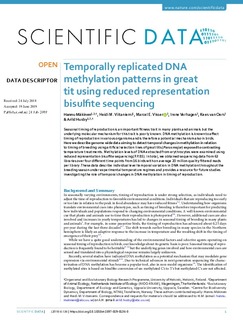| dc.contributor.author | Makinen, Hannu Sakari | |
| dc.contributor.author | Viitaniemi, Heidi M. | |
| dc.contributor.author | Visser, Marcel E | |
| dc.contributor.author | Verhagen, Irene | |
| dc.contributor.author | van Oers, Kees | |
| dc.contributor.author | Husby, Arild | |
| dc.date.accessioned | 2020-02-17T14:12:07Z | |
| dc.date.available | 2020-02-17T14:12:07Z | |
| dc.date.created | 2019-11-05T22:32:54Z | |
| dc.date.issued | 2019 | |
| dc.identifier.citation | Scientific Data. 2019, 6 (136), . | nb_NO |
| dc.identifier.issn | 2052-4463 | |
| dc.identifier.uri | http://hdl.handle.net/11250/2642054 | |
| dc.description.abstract | Seasonal timing of reproduction is an important fitness trait in many plants and animals but the underlying molecular mechanism for this trait is poorly known. DNA methylation is known to affect timing of reproduction in various organisms and is therefore a potential mechanism also in birds. Here we describe genome wide data aiming to detect temporal changes in methylation in relation to timing of breeding using artificial selection lines of great tits (Parus major) exposed to contrasting temperature treatments. Methylation levels of DNA extracted from erythrocytes were examined using reduced representation bisulfite sequencing (RRBS). In total, we obtained sequencing data from 63 libraries over four different time points from 16 birds with on average 20 million quality filtered reads per library. These data describe individual level temporal variation in DNA methylation throughout the breeding season under experimental temperature regimes and provides a resource for future studies investigating the role of temporal changes in DNA methylation in timing of reproduction. | nb_NO |
| dc.language.iso | eng | nb_NO |
| dc.publisher | Nature Research | nb_NO |
| dc.rights | Navngivelse 4.0 Internasjonal | * |
| dc.rights.uri | http://creativecommons.org/licenses/by/4.0/deed.no | * |
| dc.title | Temporally replicated DNA methylation patterns in great tit using reduced representation bisulfite sequencing | nb_NO |
| dc.type | Journal article | nb_NO |
| dc.type | Peer reviewed | nb_NO |
| dc.description.version | publishedVersion | nb_NO |
| dc.source.pagenumber | 7 | nb_NO |
| dc.source.volume | 6 | nb_NO |
| dc.source.journal | Scientific Data | nb_NO |
| dc.source.issue | 136 | nb_NO |
| dc.identifier.doi | 10.1038/s41597-019-0136-0 | |
| dc.identifier.cristin | 1744393 | |
| dc.relation.project | Norges forskningsråd: 239974 | nb_NO |
| dc.relation.project | Norges forskningsråd: 223257 | nb_NO |
| dc.description.localcode | Open Access This article is licensed under a Creative Commons Attribution 4.0 International License, which permits use, sharing, adaptation, distribution and reproduction in any medium or format, as long as you give appropriate credit to the original author(s) and the source, provide a link to the Cre-ative Commons license, and indicate if changes were made. The images or other third party material in this article are included in the article’s Creative Commons license, unless indicated otherwise in a credit line to the material. If material is not included in the article’s Creative Commons license and your intended use is not per-mitted by statutory regulation or exceeds the permitted use, you will need to obtain permission directly from the copyright holder. To view a copy of this license, visit http://creativecommons.org/licenses/by/4.0/. | nb_NO |
| cristin.unitcode | 194,66,10,0 | |
| cristin.unitname | Institutt for biologi | |
| cristin.ispublished | true | |
| cristin.fulltext | original | |
| cristin.qualitycode | 1 | |

